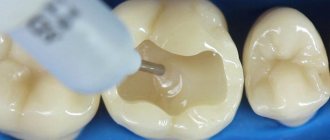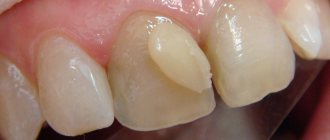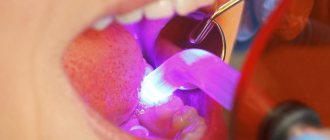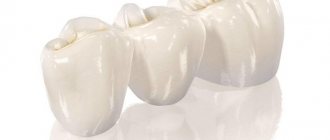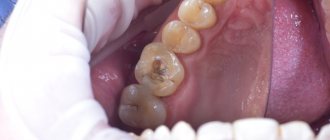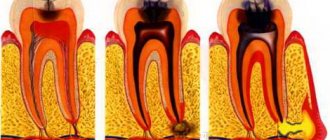Statistics from dental practice confirm the fact that light fillings are most often used and are gradually replacing other filling materials. This happens due to the objective advantages and high performance of fillings in practice.
Specialists from the network of dental clinics "LeaderStom" use light fillings of the latest developments and recommend this material for the restoration of crowns and the elimination of caries. If you notice the first signs of tooth decay and plan to eliminate it in a timely manner, then the LeaderStom clinic will be able to provide you with exactly the quality that meets the most progressive standards of dentistry.
Ceramic filling CEREC with a 50% discount
Heliocomposite composition
To understand how a light filling differs from a regular one, you need to know its composition and principle of operation. Light-curing fillings consist of a polymer matrix, glass-ceramic filler and bonding material. The principle of polymerization is a substance that breaks down into free radicals under the influence of ultraviolet rays. These radicals are responsible for the hardening of the material. The quality of stability and strength of the material depends on the size of the particles in the filler.
They can be: • mini-filled; • macro-, micro-filled; • nanohybrid.
The choice of material composition is determined by the dentist, based on hardness parameters or decorative priority.
The light filling performs the function of protecting tooth tissue from mechanical and chemical irritants. It prevents pathogenic microbes from entering the tooth and withstands significant daily loads. Therefore, the requirements for the quality of filling material are very high, and the light filling fully lives up to the expectations placed on it.
Chemical and light curing fillings
Chemically cured fillings (“chemical” fillings) harden as a result of a chemical reaction of components that are mixed immediately before the filling is placed.
Classic glass ionomer cement
(chemical curing) is a “powder-liquid” system. The powder is aluminofluorosilicate glass with a high fluorine content, and the liquid is an aqueous solution of polyacrylic acid. After mixing, the initial stage of hardening lasts about 7 minutes, the completion of the formation of the structure occurs after 2-3 weeks. The process can be accelerated by using various additives. Glass ionomer cements have the property of prolonged fluoride release, which prevents secondary caries. In addition, glass ionomer cements can absorb fluoride ions when used with fluoride toothpaste. Modern glass ionomer cements have chemical adhesion (affinity) to hard dental tissues and composite materials and good marginal fit.
Chemically cured composites
– another class of filling materials. By definition, a composite material is a mixture of several dissimilar components. In the case of dental composites, it is a mixture of filler (usually inorganic) and an organic matrix, and the filler content is quite significant (at least 30% by volume; with a lower filler content, the material is usually classified as a “low-filled polymer”). They are “paste-paste” or “powder-liquid” systems. The main advantage provided by filling teeth using such dental composites is uniform curing, regardless of the depth of the cavity and the size of the filling.
The most modern method for filling cured teeth is the method using light-curing composite materials (“light composites”, “light fillings”, “gel fillings”). These are materials in which a polymerization reaction occurs under the influence of ultraviolet light. Light-curing composite materials have a number of advantages compared to chemically curing materials:
- Before hardening the filling (irradiation with a special ultraviolet lamp), the dentist has the opportunity to more accurately restore the shape and relief of even a severely damaged tooth;
- the components of the light-curing filling material react with each other without the formation of by-products, which leads to a durable structure;
- You can choose the desired shade and transparency of the filling and achieve the desired cosmetic effect.
It should be taken into account that accelerated light polymerization (2-40 seconds) creates greater internal stress in the material in a light filling than in chemically cured composites. This can lead to cracks, so the filling is formed layer-by-layer, which also reduces polymerization shrinkage. Another feature of the installation of light fillings is the need for a reliable connection between the hydrophobic composite and hydrophilic (wet) dentin. Unlike glass ionomer cements, composites do not have chemical adhesion to hard tooth tissues. To ensure adhesion, before installing a light filling, special adhesive systems (etching gels, primers, bonds) are used, which hermetically seal (fill) all micro-holes of the tooth, or special insulating gaskets. As a result, the mechanical and chemical adhesion of the filling material (composite) to the tooth tissue increases significantly.
The advent of light-curing composite materials and modern adhesive systems has led to new principles for preparing teeth for filling. The strong connection of composite materials with enamel and dentin (connection strength 17-20 MPa and above) allows you to remove only damaged tooth tissue. Healthy tissue is removed only to create minimal access to the lesion, whereas when using filling materials of previous generations, healthy tissue was also removed (in order to create a cavity of a certain shape). The filling, instead of resting on the prepared dental tissues, has become supportive and strengthens the dental tissues. Such a filling takes on the role of lost supporting structures and allows the use of minimal intervention techniques (gentle preparation of cavities and defects in dental tissue):
- preparation focused on a specific defect shape (for example, a spherical cavity);
- removing only destroyed, non-viable dentin and leaving the enamel without dentin support (removed dentin is replaced with a composite that has the elasticity of dentin and absorbs excess loads);
- adhesive correction of the filling in case of delamination, chipping without complete replacement (which can lead to additional loss of dental tissue).
Make an appointment with the best dentists in Moscow!
Durability
The average lifespan of light seals is about five years. However, in practice, they can keep the tooth intact for much longer. For greater durability of the filling, dentists at the LeaderStom clinic recommend carefully monitoring oral hygiene, proper nutrition and sufficient calcium intake into the body.
Stable fastening of the light filling is achieved through an adhesive system - a special light-sensitive liquid that is used to treat the tooth walls. Performing the function of “glue”, it so firmly connects the photopolymer material with the tooth enamel that subsequently a chemical calcium exchange begins to occur between these tissues.
What components are included in the photopolymer filling (light filling)?
In the process of producing photopolymer filling material, heliocomposite is used, which includes substances that can break down into radicals under the influence of ultraviolet light. This is precisely what underlies the polymerization of a light filling, and this is its main distinguishing feature from a chemical filling.
The photopolymer may contain various fillers, which affect the characteristics of the installed filling and determine its service life. In particular, light-curing fillings may contain the following components:
- Macrophiles are large inorganic components that make the filler highly durable, give it good optical qualities and have radiopacity. Also, the features of such particles include: resistance to polishing, increased roughness, color instability, the ability to carry out restoration of chewing teeth and the frontal group;
- Microphiles - they contain small particles that are easy to polish, have a durable glossy surface, have color stability, are famous for their excellent aesthetic characteristics and provide minimal abrasive wear. However, such components are characterized by low resistance to mechanical stress. Using microfilled components, it is possible to create facing plates and eliminate deficiencies that are not associated with carious lesions;
- Minifilled - represent a combination of the quality of microphiles and macrophiles, but are almost never used in real dental practice. They are characterized by low strength, are difficult to polish, have insufficient aesthetic properties, and have low resistance to excessive mechanical loads. Such fillers can be used to restore front and posterior teeth that have minor cavities;
- Nanohybrid - presented in the form of tiny particles that have universal characteristics, surpass all other components in aesthetics and mechanical strength, and can be used for a wide variety of filling purposes. In particular, nanohybrid composites are used to restore aesthetic defects of teeth.
Biological compatibility
It is known that filling material such as amalgam, which was used several years ago for dental treatment, contains mercury in its composition. Another material, glass ionomer cement, is also used in dentistry, but contains fluoride, which recent research suggests may be harmful to the pineal gland. In this range of filling materials, light fillings are distinguished by their maximum biological compatibility. They do not emit toxic substances, do not destroy the tooth crown (as cement composites do due to higher hardness than the tooth), and have optimal expansion-compression characteristics under temperature changes.
Benefits of light filling
Light polymerization fillings are more modern, which means they are created using improved technology, which distinguishes this material from chemical ones. What are the advantages of a light filling over a regular one?
- High plasticity. The dentist can safely form the crown of the tooth without fear that the material will harden ahead of time and something will be left unfinished. The light composition hardens only under targeted exposure to an ultraviolet lamp.
- Softness of the material. The special structure of the composition allows you to qualitatively fill all the anatomical convolutions in the tooth cavity and adhere tightly to the edges. Fits perfectly on any teeth: front and back.
- Hypoallergenic, non-toxic composition. This filling can be placed during pregnancy and the lactation period - it is completely harmless to the body.
- Wide range of shades. The dentist can choose the natural color of the enamel for any patient, and this is very important when filling the front teeth.
- Compliance of the material. It is easy and quick to sand and polish.
- Rapid maturation of the material. After installing the light-curing composite, the patient can eat food almost immediately without fear of escaping.
- Less painful tooth preparation. The patient will not suffer much from contact with the drill.
- Wear resistance. A light seal can serve a person for more than 5 years.
When treating a chewing tooth that is not too neglected, the patient, as a rule, can save on filling material and choose a chemical one. But when it comes to the smile itself, then you simply cannot do without the use of a light filling with its significant advantages.
Category Dental filling Posted by Mister stomatolog
High aesthetic characteristics
The aesthetic factor is especially important when eliminating caries on the front teeth. The material of the photo light seal lends itself perfectly to final processing: grinding and polishing. And the color set provided by raw material manufacturers includes the full range of possible shades of tooth enamel. This fact allows you to accurately imitate the natural color of the tooth in the absence of boundaries between the enamel tissue and the filling. Even after several years of use, it can be quite difficult to determine this boundary, and immediately after tooth restoration it is simply impossible.
The effect of preserving tooth color gradations is possible thanks to the use of the latest layer-by-layer application technologies. The so-called polychrome filling uses more than two color components: darker at the base of the tooth and lighter towards the cusps. The most modern compositions of filling materials used in the LeaderStorm clinic were developed using nanotechnology. They allow you to achieve maximum aesthetic effect when restoring a tooth.
There are rare exceptions when priority is given to chemical composites. For example, when installing the material in a place that is difficult to reach for ultraviolet radiation. If a tooth restoration is carried out with a light filling, then the light polymerization will not be effective and the composite will not harden properly. In such situations, a chemically cured material is recommended.
All of the above advantages of light seals, reviews are very positive, which is confirmed in practice.
How much does a light seal cost?
Prices for dental work in reliable clinics are based on how complicated (or neglected) the tooth is. The cost of a light filling also depends on the condition of the tooth - the depth of the carious cavity, the degree of destruction of the walls, and the health of the canals. The more work the dentist requires, the higher the price will be. But the financial side of the issue may depend not only on the illness that the patient brought with him. If the clinic has a high status and brilliant authority, the price for a light filling may be too high. This is how reputable clinics maintain their status. Conversely, if a dental office has opened recently, and its main task is to attract customers, the price tags for services may be low.
In general, the cost of a light-curing filling ranges from 2,000 to 15,000 rubles. But higher prices are also possible (as a rule, in cases where the tooth is too neglected). Filling the front teeth is always more expensive than the back teeth, because the smile area requires the highest quality and most expensive materials. The variety of dental clinics today is too great to not know where to go. Each patient decides for himself what to choose: either too expensive treatment, but with a guarantee of quality, or hope for a successful result and significant savings. There is a third option: price and quality in equal proportions - you need to choose this one. As a rule, many patients rely on reviews from friends and acquaintances, and on this basis they choose a clinic and a dentist. The most important thing is not to forget that a healthy smile is priceless.
How to care for your mouth after having a light filling installed
How long after light filling can you eat? In order to maintain the original characteristics of the light seal, it is recommended:
- After installing the light filling, it is recommended not to eat for 2 hours.
- For three days after filling, avoid consuming staining foods and drinks;
- Strictly follow hygiene procedures;
- Undergo a follow-up examination with a dentist 5-6 months after the filling is installed.
Thus, we have looked at what a light seal is. It makes it possible to restore chewing and anterior teeth with minimal risk of relapse. For example, to restore the aesthetic properties of a smile, it is better to use expensive light-composite materials, and for restoration of the lateral area, dental materials of average cost are ideal.
